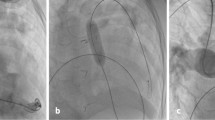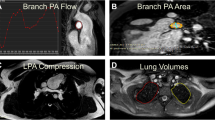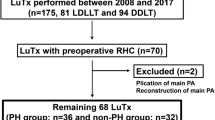Abstract
Objectives: We evaluated the possibility of expanding indications for pulmonary resection based on an assessment of the pressure-flow relationship in pulmonary circulation.Methods: In 6 of 28 lung cancer patients whose total pulmonary vascular resistance index exceeded the threshold during unilateral pulmonary artery occlusion testing, we conducted unilateral pulmonary artery occlusion testing with dobutamine administration, followed by lung resection. We studied hemodynamics during testing and derived a new indication for pulmonary resection from the postoperative course.Results: Cardiac output was 3.82±0.74 l/min before testing, 3.66±0.76 l/min during pulmonary artery occlusion testing, and 5.92±1.78 l/min during unilateral pulmonary artery occlusion testing with dobutamine infusion. The total pulmonary vascular resistance index was 890±350 dyne·sec·cm−5·m2 before testing, 1170±320 dyne·sec·cm−5·m2 during testing, and 800±160 dyne·sec·cm−5·m2 during testing with dobutamine infusion. Cardiac output increased (p = 0.014) during unilateral pulmonary artery occlusion testing with dobutamine infusion, and the total pulmonary vascular resistance index significantly decreased (p = 0.034). Of the 4 patients eligible for lobectomy, 2 underwent the procedure — one undergoing segmentectomy in which pulmonary metastasis was found during surgery and the other undergoing radiotherapy for cN2 disease with chest wall invasion. Of the 2 initially ineligible for lobectomy, one underwent partial pulmonary resection and the other underwent lobectomy because the total pulmonary vascular resistance index was less than 800 dyne·sec·cm−5·m2 during selective pulmonary artery occlusion testing with dobutamine infusion, indicating eligibility for lobectomy. No severe complications of cardiopulmonary function failure after surgery occurred in any of the 5 cases.Conclusions: Unilateral pulmonary artery occlusion testing with dobutamine infusion is useful in determining patient eligibility for pulmonary resection.
Similar content being viewed by others
References
Kawana H. Exercise tolerance assessed by unilateral pulmonary artery occlusion test before and after pulmonary resection. Jpn J Thorac Dis 1994; 32: 446–52.
Carlens E, Hanson HE, Nordenstrom B. Temporary unilateral occlusion of the pulmonary artery. J Thorac Surg 1951; 22: 527–36.
Kajitsuka S. A study on the physiological safety limit for the lung resection by temporary unilateral occlusion of pulmonary artery. Kosan Ken Zas 1957; 13: 1–21.
Nitta S, Ohkuda K, Onuki T, Koike K, Ishiki M, Tanita T, et al. Clinical assessment of our progress in evaluating patients with bronchogenic carcinoma for lung resection. Kosan Ken Zas 1985; 37: 319–25.
Nitta S, Ishiki M, Koike K, Onuki T, Ohkuda K, Hashimoto K, et al. Assessment of ability to withstand lung resections and postoperative survival in patients with respiratory disorders and bronchogenic carcinoma. J Jpn Surg Soc 1985; 86: 1038–40.
Suzuki S, Tanita T, Koike K, Ashino Y, Nasu G, Kubo H, et al. Evaluation of Cardiopulmonary Function for Lobectomy under the Condition of Selective Pulmonary Artery Occlusion Test (SPAO). J Jpn Assn Thorac Surg 1991; 39: 1147–52.
Fishman, AP. Dynamics of the pulmonary circulation. Handbook of Physiology. Circulation II, American Physiology Society, Washington, D.C., 1963: 1667–1743.
Nakada T. Pulmonary circulation. B. Pulmonary circulatory disorders. Jpn J Thorac Surg 1973; 26: 467–73.
Fishman, AP. Pulmonary circulation. Handbook of Physiology. The Respiratory System Vol. I, American Physiology Society, Bethesda, 1985: 93–165.
Onuki T, Itaoka T, Kei J, Yokoyama M, Nitta S. Correlation between slopes of pulmonary blood flow-driving pressure curve and routine pulmonary function. Jpn J Thorac Dis 1990; 28: 428–33.
Onuki T, Ishiki M, Tanita T, Funada J, Isogami K, Saito H, et al. Pulmonary function evaluation of lung resection candidate: hemodynamic studies. Gekashinryo 1986; 8: 949–57.
Koike K, Tanita T, Sakuma T, Ono S, Ashino Y, Kubo Y, et al. Surgery for the Patients Whose Total Pulmonary Vascular Resistance Was over 700 Dyne During Unilateral Pulmonary Occlusion Test. J Jpn Assn Thorac Surg 1992; 40: 2011–4.
Tuttle RR, Mills J. Dobutamine: development of a new catecholamine to selectively increase cardiac contractility. Circ Res 1975; 36: 185–96.
Isogami K. Acute residual lung function of the operated side in lobectomy. Kosan Ken Zas 1989; 41: 53–67.
Author information
Authors and Affiliations
Rights and permissions
About this article
Cite this article
Ikeda, T., Onuki, T., Nishiuchi, M. et al. Clinical assessment of unilateral pulmonary artery occlusion test with dobutamine infusion. Jpn J Thorac Caridovasc Surg 48, 802–808 (2000). https://doi.org/10.1007/BF03218255
Received:
Accepted:
Issue Date:
DOI: https://doi.org/10.1007/BF03218255




